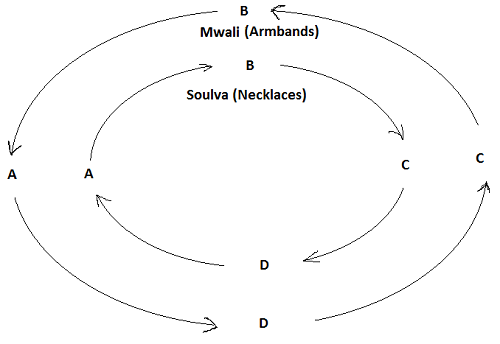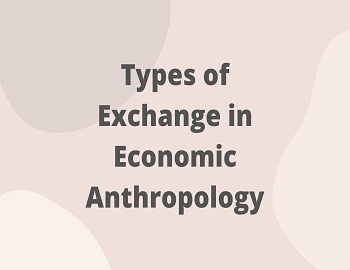Table of Contents
Types of Exchange:
Most of what is produced by human labour are distributed by means of exchange. Exchange refers to the pattern of giving and receiving valuable objects and services. Human beings can not live without exchanging their labour or the products of their labour with one another. The pattern of exchange varies from one society to another. Following Karl Polanyi, we will distinguish three modes of exchange- reciprocal, redistribution and market. Although all three may operate as component aspects of a single economic system, it is usual for one or another of them to be dominant in structuring the process by which most consumer goods and services are moved within a particular society.
Reciprocity:
It is a mode of economic distribution in which resources are presented by one individual or one group to another individual or group with the expectation on both sides that sooner or later the second will return something of approximately the same value to the first. More plainly, it refers to the giving and taking between people who are bound by social ties and obligations. It ranges from gift-giving to equalized barter and self-interested cheating (although in the latter reciprocity is not involved). Reciprocity is crucial in primitive societies; it plays a fundamental part in hunting-gathering, horticultural and pastoral societies. Marshall Sahlins distinguished three subtypes of reciprocity-
Generalized Reciprocity:
- This is gift-giving without an immediate or planned return.
- No accounts are kept.
- It usually takes place between kin or close friends, but it is typical of the family, where parents feed and take care of their children with no calculation of expected return, although presumably one or more of their children will feed them and take care of them when they are old.
- Gift-giving is not altruism, but an affirmation of the importance of interdependence.
- People remember their gift-giving activities and if they were not reciprocated they would express strong disaaproval.
- Generalized reciprocity does not collapse when resources bceome scarce, rather the opposite happens. However, under extreme scarcity (famine), the gift-giving system may breakdown or be limited to the household.
Balanced Reciprocity:
- Here, the partners are linked by reciprocal relationships. The parties concerned are not relatives yet they know each other. Example- the trade between Bushmen and Tswana of Africa highlights the process of balanced reciprocity.
- Silent trade or dumb barter is another example of balanced reciprocity. In this there is no verbal communication between parties concerned. Example- semang of Malaya, Veddas of Sri Lanka, Raji of Uttar Pradesh.
- Kula trade otherwise known as kula ring/kula exchange or ceremonial exchnage is another example of balanced reciprocity. Example-Trobriand islanders and other islanders of Melanesia.
Kula Exchange:
In Melanesia, some islands have a food surplus but shortages of tools, some other Islands have surplus tools but shortages of food. No Island has the skills to produce all the goods to be consumed. Under these circumstances, one Island depends upon another Island to get the required items. This created the Kula exchange.
The exchange of shell ornaments with their trade partners were made in the Kula trade. The ornaments, known to the Trobrianders as vaygu’a, consist of armbands and necklaces.

Two kinds of ornaments are involved in the ceremony of exchange white shell armbands, known as “Mwali” which travel around the circle of Islands in a counterclockwise direction, and red shell necklaces known as “Soulva” which travel around the Islands in a clockwise direction. As each of these article travel around the Islands, it meets and is exchanged for an article of the other type. Every detail of the tradition is fixed by tradition. In every village, on the participating Islands, some of the men take part in the Kula. These men receive the necklaces or bracelets from their trading partners, hold them for a while and then pass them on. No man keeps any article in his possession permanently. The partnership is often maintained for years. A commoner may have five or six such relationships, but a chief may have as many as seventy.
When the leaders are exchanging ceremonial goods, their fellowmen will be engaged in barter activities. They exchange their goods for the goods of others. In this context, considerable bargains go on.
Thus, the Kula system serves the following functions-
- Indicates status of individuals who are parties to the transaction.
- Creates peaceful atmosphere for affecting the barter system.
- Provides congenial atmosphere for renewal of friendship and for creation of new partners.
- Keeps the partners in ever lasting obligations of reciprocity and exchange of maternal goods.
Negative Reciprocity:
According to Sahlins and Service, it is an exchange in which the giver tries to get the better of the exchange. Example-
- Navajo Red Indians quote high prices for their products. The Whites purchase the goods from them paying the quoted price. In this transactions, the giver gets better of the exchange.
- Thefts and raids are perfect examples of negative reciprocity. They take place in Nuer, Kirgis, Dinka, Kazak settlements highlight the process of negative reciprocity.
Redistribution:
- It is a mode of economic distribution in which resources are presented to a central authority that then allocates them to the members of the group.
- It means the reallocation of society’s wealth by means of obligatory payments or services.
- The central collecting source may be a chief, a king, a religious leader or the state.
- The resources collected are later re-allocated to the society as a whole in the form of community services to support infrastructures or public institutions (army, state, bureaucracy etc.) and to maintain the class system.
- In chiefdoms a number of resources are redistributed- hunting sites, unused land, food surpluses and son on.
- By accumulating and storing resources, the chief is in a position to redistribute them in times of scarcity and hence guarnatee an adequate subsistence for all the members of society.
Market Exchange:
- A mode of economic diistribution in which resources are exchanged on the basis of prices established by supply and demand and expressed in generalized units of value.
- In other words, it is the trading of goods and services through a common medium of value-money.
- This is a type of transaction removed from social considerations of kinshsip and friendship.
- Not all market exchange are impersonal; often , trading partners establish long-term relationships based on mutual trust.
- In the market situation it is common to have a broker or middleman who facilitates the dealings between sellers and buyers.
- In some traditional societies markets may be limited to certain goods, but land might be excluded from transactions.
- In modern, caopitalist society everything is bought and sold.









Comments (No)